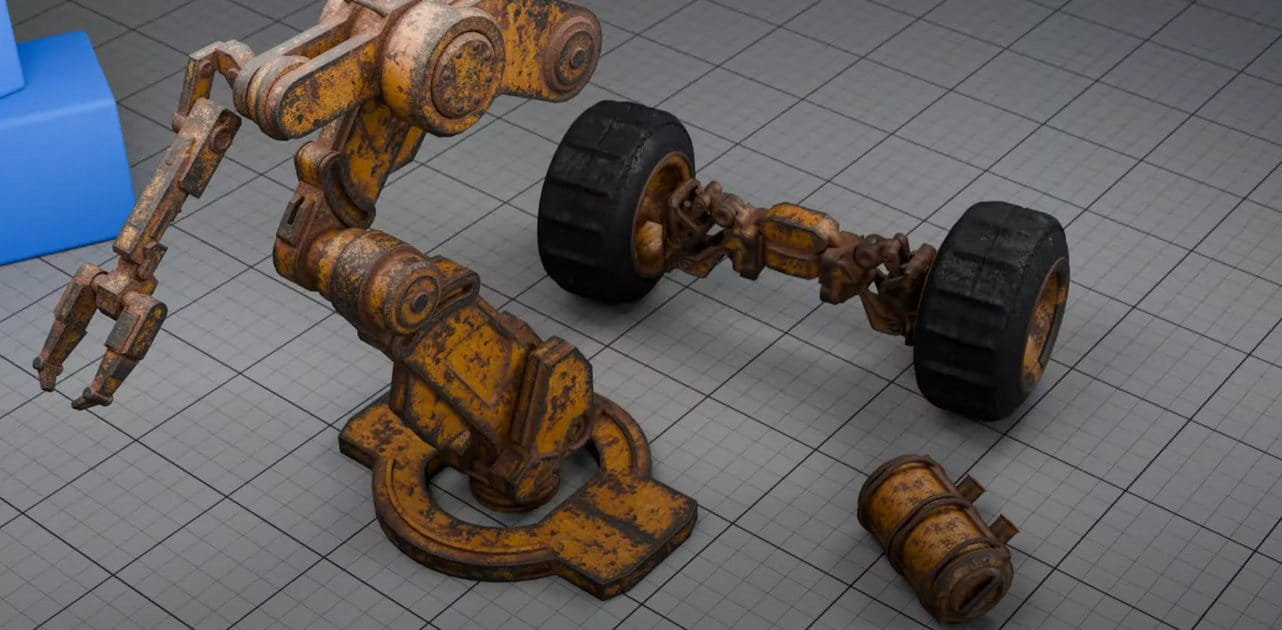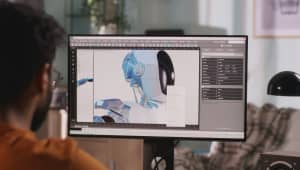One of the most popular products is Softimage SOFTIMAGE|XSI. XSI is a product that was created 5 years ago. In this review we will take a closer look at the 4th version of this great software. The evolution of XSI was dictated by the demanding requests from the industrial vizualisation market and movie's postproduction and f/x departments. Most of the users are movie companies and freelancers from the CG field, and recently XSI has been used with a large amount of success in the fast growing game design market. The Evermotion Team believes that it will open up this great product for architects, who would like to increase quality of their products. XSI includes the powerful mental ray 3.3, and the power of it we don't have to advertise...
The layout of XSI is very aesthetic, understandable and user friendly. Perfectly designed buttons, subdued colors and text that is clear - this is standard in XSI. Well, it's a great tool for all those artists who have got good taste :). The XSI engine is made in java so users are able to customize it exactly like they want. But the default settingss are so clear and powerful that beginners will have no problems using this product. In every tool over the keyframe we can see small helpers that inform us about options that are available in this time spot under mouse buttons - it's great feature for beginners. Of course we are able to change the keymaping and made it correct for us. In the XSI layout we can find 6 sections - they are Model, Animate, Render, Simulate, Hair and Weight Panel. What is great about this feature is when we switch between the layouts, it only changes options and tools, so we don't have to open many new windows and tables, which is perfect so we can keep our scene organized, unlike other 3d software.
Windows of mapped keys are transparent and understandable. It's very helpful because we can check what function is actually mapped to the key. Of course XSI is greatly adapted toward networks - we can install the workflow module or set it up only on render slave. This is very fundamental in teamwork. In the workflow mode all the nodes you add to the node tree are very manageable. For example if you created a very complicated scene within maya - you will probably find yourself confused about all the nodes put together into the outliner. It's very simple in XSI and contains a user-friendly interface. Step by step and go. The set-up of all tools in the layout can be saved and used in the future.

The Custom Display Host is a new framework to host custom viewers or custom applications as views in XSI, allowing interaction between XSI and the other application. This way, a game engine or foreign application can easily be embedded into XSI with minor modifications. The CDH API allows the hosted application to receive and filter events as they occur in XSI. The custom view can also modify the XSI scene simultaneously. DX or OpenGL display allows users to see how the model will look in the final render - and this is very fast.
While previous versions of XSI had some ghosting ability, it was nothing like the new ghosting that has been implemented in XSI 4.0. With the new functions you can ghost just about any animated function. Hair, Bones, Cloth, Softbodies, Hardbodies, etc. You can even turn on ghosting during the creation of rigid body dynamic simulations, adjust the sliders, change the position of objects and see how they will affect your simulation when it plays. No more tweaking values and running simulations a 100 times until your ball makes it through the hoop. Ghost it into the future, then adjust your sliders until the ghost shows the ball going where you want it to. This is a tremendous timesaver.

The modeling process in XSI is very pleasant. Every movement of vertex is remembered like operator that we can delete or edit in the future - it's great and so powerful, because in XSI we don't have to worry about every step - we can simply correct it every time we want. We can create our object using nurbs and poly. In the beginning we are able to choose many kinds of curves that will be used to build our models surface. The smoothing of our surface can be controlled by changing the value of subdivisions. We can fast smooth our object, simply by pressing "+" and "-" keys - by adding or deleting subdivision - and what is very important is that this operation doesn't slow our viewport! Differently from other 3D software packages, when we increase the number of subdivisions our scene is much "heavier" or even crashed the program. Nurbs in XSI are easy to control and one of my favorite tools in XSI is quadrangulate. Thanks to this we can take any mesh (scanned by a 3D scanner, imported from other 3D application) and change all 3-side polygons to 4-side polygons. I love this tool because it is never fails, and you should remember that today almost all models used in movie f/x are made in clay and then scanned. In XSI we are able to use layers for all objects and even animation in our scene, and this will make our work faster, easier and give us better access to concrete objects. Objects on other layers will have gray, transparent colors. I think, that the layers in XSI are much better designed than in others applications.
Mental ray is famous rendering software that has been used in many of today's movies f/x. In XSI v. 4 we are able to use mental ray v3.3 which features a wide range of improvements and innovations, such as motion interpolation with late shutter-opening for new high-speed motion blur. Quickly preview final gathering lighting using fast lookup, and make sure of artifact free results with precise photon volume accuracy control. New memory management options and view dependent final gathering generation make rendering complex scenes faster and more efficient. Shadow map enhancements include bias, bsp maximum memory options, and detail shadow maps. There are additional enhancements to toon shader, new hemispherical (fisheye) lens shader and visible light renders.
Displacement in XSI is perfect. It's fast and has very good quality. Of course it's based on multi-triangle technology. The new mental ray provides final gathering preview, which makes lightning much easier. During calculation process we are able to see our vizualisation with colors and lightning near the final image. Thanks to this we can stop the rendering process when we decide that our sets are wrong - and for you old school modelers, who for many years have been rendering teapots and boxes - this can save plenty of time:) Lights in XSI allow us to simulate all natural effects, like area shadows, light attenuation or volumetric effects, that give our photorealistic renders that final look. Support for radiance map (hdri) allows us to light our scene with photorealistic effects.
XSI's great texture editor allows users to control all mapping details. UV unwrapping automatically creates artist-friendly, manageable UV islands With connectivity tabs and new island healing, and UV stitching takes only seconds. XSI also includes new visual feedback and selection of UV samples for easy UV selection, as well as new, automated Cubic Texture Mapping.
The render tree provides users "hydraulic" visualization of shaders, and amazing "region" options allow us to see quick preview of the shader in our scene. This revolutionary and quite simple technique allows us to check how our shaders look and, most importantly, to see the influence of the environment to our shader. Toonz shaders are included in standard product price!
With the new metashaders system, XSI shaders can now be written to work with multiple renderers, and the new XGS display will even allow 3rd-party renderers to have dedicated interactive preview windows directly in XSI. You could set up a rendertree for mental ray and use that same tree to render via NVIDIAS’ CG shading language. Rendering in layers technique is a part of XSI core - so we don't have to use another software like After Effects or combustion for final image composition. Everything we need is in XSI – the compositing window gives us the opportunity to use all masks and filters.

XSI further extends the character creation and control possibilities with the new Character Development Kit. The CDK includes all new biped and quadruped guides and rigs as well as a new Dog Leg rig. The CDK includes a new spring-based tail-maker as well as control splines for deformations. These high-level creation tools make building sophisticated rigs easier and faster.
Incredibly fast and interactive, XSI takes Rigid Body Dynamics to a new level. A single unified environment controls forces, operators and constraints. Motor-driven hierarchies work seamlessly with dynamic constraints to allow articulated models to move autonomously in the simulation environment. Real-time interactivity means that while playing-back, the user can interact with the simulation and add animation. All simulations can be blended in the animation mixer and layered using the advanced caching.
Natural Forces like Gravity, Wind, Fan, Drag, Attractor (Magnet), Vortex, Eddy (Vacuum), Turbulence allow users to simulate almost all effects from real world. Explosions, fire, snow, water - all this is peace of cake with XSI.
Soft body is a tool that allows us to create effects of flexibility of objects in the scene - like cloth, rubber, clay and much more. This effect is quite complicated, but here is nice surprise - in XSI it is incredible easy! We can even divide our objects on fragment that are more and less flexible. Thanks to soft body, we are able to create walking through mud or tire's tracks.

Particle goals have been added to v.4. Goals allow a simulated particle cloud to be attracted by one more or more objects. The goal object can be a polygon mesh, nurbs surface, lattice, particle cloud, nurbs curve, or any other object. Each particle is assigned a feature of the goal object to be attracted to. Using the new Hair Geo shader, you can set the diffuse/ambient/specular color shading and transparency for hair that uses only the geometry render type. This offers better control (via gradient) over shading. You can also add incandescence (glow) for the inner and outer hair edges. You can control the hair's width by using inner/rim emissive color and transparency tapering, which improves the hair's overall look and reduces hair flickering. This way, you don't need to change the width of the actual hair geometry.
Hair is now split into separate objects in roughly 400,000 strand chunks. This results in roughly 40,000 hairs per object, given the default ten segment hair for improved performance. If necessary, this can be adjusted by using the environment variable SI_HAIR_CHUNK_SIZE, which can be used to specify a different chunk size. The built in rigs have improved a lot. You can now move the toe and the entire foot will move with it as well. You now get components that you can simply add to your rigs, such as fingers, hands, tails etc. There are also more options that enable skin sliding, better shadow rigs and ghosting, which is very valuable for accurate animation. Here are some of the new additions to rig making. Dog Legged Biped is a new guide and rig generation script for dog legged bipeds. Quadruped rig has a tail by default and can have shadow hierarchies. You also have the ability to create tails on bipeds by duplicating cube on base of the spine. There is an option to create a rig with ears. Biped guides have finger controls to control hands that can have fewer than 5 fingers (by deleting fingers on the guide). Fingers can have an arbitrary number of bones (by deleting or duplicating finger joint guides) There is also a new Create Control splines tool.
Scripting in XSI is a huge field for all those graphic designers who have programming skills. They are able to use VBScript, JScript, PerlScript, Python and many more scripting languages. Thanks to this users are able to make their own plug-ins, shaders or create unique actions.
You can add audio files to your scenes using the animation mixer. This allows you to adjust the timing of your animations by using the sound as a reference. For example, you can use an audio file as reference for lip synching (the most common use of audio with animation) with a shape-animated face, or sync up some special effect noise with an animation. Or you could load an audio file to do some previsualization or storyboarding as you’re experimenting with your animation project.

PRICES:
XSI v.4.0 Foundation: $495 USD
- 2 CPU mental ray® v.3.3 rendering
- Advanced Subdivision Surface Modeling
- Full cloth & particles
- Node floating
- NLA3 Full Nonlinear Animation, Audio, and Actions
- Everything you need.
XSI v.4.0 Essentials: $1995 USD
- 2 CPU mental ray v.3.3 rendering
- 4 node Satellite rendering
- BatchServe v.1.5.3
- Custom Display Host
- Rigid & Soft Body Dynamics
- Node floating
XSI v.4.0 Advanced: $6995 USD
- 4 CPU mental ray v.3.3 rendering
- 8 node Satellite rendering
- BatchServe v.1.5.3
- Professional tree-based compositor
- 2-D raster & vector based resolution independent paint tools
- Industry-leading hair & fur
System requirements: version 4.0: Windows XP Pro and 2000
Workstation with AMD K7 or higher processor
Workstation with Intel Pentium III or higher processor
OpenGL accelerated graphics card
520 MB of available hard disk space for full install. Additional space required during setup for decompressing files.
1280x1024 screen resolution recommended
256 MB RAM minimum, 512 MB RAM recommended
3-button mouse
Access to a CD-ROM drive to run the Setup program and to access the online documentation (if it is not installed on your hard drive)
System requirements: version 4.0: LINUX
Operaring System Red Hat Linux version 7.3, 8.0 9.0 or Enterprise version 3
Default GNOME window manager or KDE recommended.
You should also be able to run XSI on other Linux distributions provided you keep to the following guidelines, including the above required components:
Kernel: 2.4.18-3 - 2.6.5
XFree86, XFree86-libs: 4.2.0, 4.3.0
Window managers: Metacity, KDE, Sawfish (without "follow mouse focus" policy), twm, WindowMaker, Enlightenment
glibc: 2.2.x, 2.3.x
The following components are also required: libjpeg, libncurses, e2fsprogs, fam
The following components are required mainly during the installation process: sed, textutils, grep, fileutils, xinetd, bzip2, tar.
HARDWARE
Workstation with AMD K7 or higher processor
Workstation with Intel Pentium III or higher processor
OpenGL accelerated graphics card
730 MB for a full installation. Additional space required during setup for decompressing files.
1280x1024 screen resolution recommended
256 MB RAM minimum, 512 MB RAM recommended
3-button mouse
Access to a CD-ROM drive to run the Setup program and to access the online documentation (if it is not installed on your hard drive)
All those, who would like to check power of XSI we would like to invite to browse the Softimage web site, where you can find the educational version for only $175 USD, and every XSI EXP completely for free
HIRE. This version is based on XSIv.3.0 but in near future it should be availablefor XSI v.4.0.
For all those who would like to learn more about XSI - please browse our tutorials section, where we have published many new XSI tutorials.
SOFTIMAGE.
Best Regards,
Evermotion Team














































COMMENTS